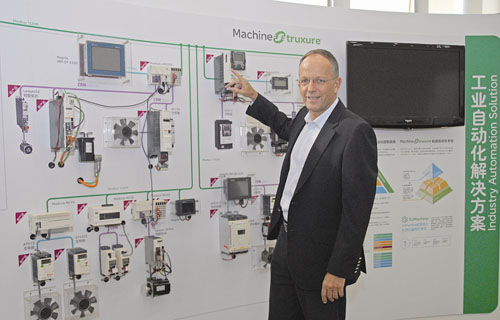Schneider helps cities switch on to save
Updated: 2012-11-21 11:14
By Meng Jing (China Daily)
|
|||||||||||
Opportunities abound as company's projects suit China's soaring demand
Every working day exactly 15 minutes after employees at Schneider Electric's China headquarters in Beijing are to leave work, the lights in the building go out. Those who need to stay late have to turn them back on to prevent their workspaces from being shrouded in darkness.
It is that kind of attention to saving energy that helped the French energy management company reduce the power used in its Beijing building from 160 kilowatt-hours per square meter a year in 2009 to 105 kW/h in 2011. The company now says it expects to have the amount reduced to 90 kW/h by 2014.
|
 |
|
Patrick Gaonach is China senior vice-president of strategy and business development at Schneider Electric. [Photo/China Daily] |
Making buildings energy efficient is one of Schneider Electric's specialties. And it has now set its sights on a bigger goal: making cities more sustainable, efficient and livable.
"It doesn't make sense to be leaders in energy management if we cannot address expectations and challenges cities are facing today," said Patrick Gaonach, China senior vice-president of strategy and business development at Schneider Electric.
"And China will represent a big proportion of this new market for us due to the number of its cities and the challenges they have."
Starting this year, Schneider Electric has been preparing to move forward with its initiative, Smart City Solutions, which will use different kinds of technologies to efficiently manage cities' energy, environments, water, space and other resources.
Gaonach noted that cities occupy about 2 percent of the land in the world but are home to about half of the population, use about 75 percent of the energy and are the source of about 80 percent of carbon emissions.
"As everyone wonders how to meet the growing demand for energy and resources while drastically reducing global carbon emissions, one thing is clear: This challenge will be won or lost in the cities," said Gaonach, who has worked for Schneider Electric for about 25 years.
In the pursuit of its goals, Schneider Electric is working with around 230 cities and regions on projects to help them improve the efficiency and sustainability of their urban infrastructure, set and meet ambitious environmental goals and all the while staying within their budgets.
Schneider Electric is working on a variety of projects in Europe and even more in the United States. But of all the countries where it has a presence, China probably has the strongest will to make its cities sustainable, Gaonach said.
The scale and pace of urban expansion in China is unprecedented. Last year, for the first time, more than half of the 1.3 billion people making up its population were classified as urban dwellers.
According to a report by the economics think tank McKinsey Global Institute, as many as 100 of the world's top 600 cities are expected to be in China by 2025.
"Going green is definitely a trend among Chinese cities, no matter how big or small they are," Gaonach said. "With rapid development, cities also want to be more cost-effective, not only in building those cost-intensive infrastructures, but also in operating and maintaining them.
"Last but not least, citizens in China are now becoming more and more demanding. They want cities to be more convenient and livable."
Such demands are broad, he said. And Schneider Electric is working to meet them in a variety of ways, whether it be through providing power grids, transport, water and public services or buildings and residences.
"For sure, it is quite a significant move for Schneider Electric, which is moving from being a hardware and software provider to more and more integrated solutions," Gaonach said. "But this is a strategic direction we are taking to better meet the needs of our key stakeholders in China."
Related Stories
Datong, Schneider to cooperate in exploiting new energy 2012-03-23 12:13
Schneider buys clean tech company for $650m 2011-06-10 10:54
ABB, Schneider bid for China cleantech firm 2011-06-07 15:59
Schneider Electric names Chinese exec 2009-12-14 08:02
Special report: Schneider confirms commitment to the Chinese energy market 2009-03-17 07:43
Today's Top News
President Xi confident in recovery from quake
H7N9 update: 104 cases, 21 deaths
Telecom workers restore links
Coal mine blast kills 18 in Jilin
Intl scholarship puts China on the map
More bird flu patients discharged
Gold loses sheen, but still a safe bet
US 'turns blind eye to human rights'
Hot Topics
Lunar probe , China growth forecasts, Emission rules get tougher, China seen through 'colored lens', International board,
Editor's Picks

|

|

|

|

|

|





